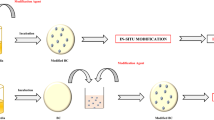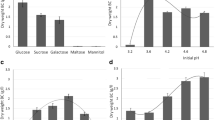Abstract
In this study, microcrystalline cellulose (MCC) was prepared from the acid hydrolysis of bacterial cellulose (BC) produced in culture medium of static Acetobacter xylinum. The MCC-BC produced an average particle size between 70 and 90 μm and a degree of polymerization (DP) of 250. The characterization of samples was performed by thermogravimetric analysis, X-ray diffraction, and scanning electron microscopy (SEM). The MCC shows a lower thermal stability than the pristine cellulose, which was expected due to the decrease in the DP during the hydrolysis process. In addition, from X-ray diffractograms, we observed a change in the crystalline structure. The images of SEM for the BC and MCC show clear differences with modifications of BC fiber structure and production of particles with characteristics similar to commercial MCC.




Similar content being viewed by others
References
Klemm D, Heublein B, Fink HP, Bohn A. Cellulose: fascinating biopolymer and sustainable raw material. Angew Chem Int Ed. 2005;44:3358.
Barud HS, Ribeiro CA, Crespi MS, Martines MAU, Dexpert GHYS, Marques J, Rodrigo FC, Messaddeq Y, Ribeiro SJL. Thermal characterization of bacterial cellulose—phosphate membranes. J Therm Anal Calorim. 2007;87:815–8.
Sjöström E. Wood chemistry—fundamental and applications. San Diego: Academic Press; 1981. p. 52–5.
Iguchi M, Yamanaka S, Budhiono A. Bacterial cellulose—a masterpiece of nature’s arts. J Mater Sci. 2000;35(2):261–70.
Jonas R, Farah LF. Production and application of microbial cellulose. Polym Degrad Stab. 1998;59:101.
Bielecki S, Krystynowicz A, Turkiewicz M, Kalinowska H. Bacterial cellulose. In: Steinbuchel A, editor. Biotechnology of biopolymers, from synthesis to patents, vol. 14. Heidelberg: Wiley; 2005. p. 381.
El-Sakhawy M, Hassan ML. Physical and mechanical properties of microcrystalline cellulose prepared from agricultural residues. Carbohydr Polym. 2007;67:1–10.
NBR 7730.Pulp—determination of viscosity in cupriethylenediamine solution (CUEN) using capillary viscometer. 1998.
Bolhuis GH, Chawhan ZT. Materials for direct compaction. In: Alderbon G, Nyström C, editors. Pharmaceutical powder compaction technology. New York: Marcel Dekker; 1996. p. 419–501.
Paralikar KM, Aravindanath S. Crystallization of cellulose. J Appl Polym Sci. 1988;35(8):2085–9.
Muñoz-Ruiz A, Antequera VV, Parales CM, Ballesteros RJC. Tabletting properties of new granular microcrystalline celluloses. Eur J Pharm Biopharm. 1994;40(1):36–40.
Filho ECS, Santana SAA, Melo JCP, Oliveira FJVE, Airoldi C. X-ray diffraction and thermogravimetry data of cellulose, chlorodeoxycellulose and aminodeoxycellulose. J Therm Anal Calorim. 2009;100:315–21.
Nelson ML, O’Connor RT. Relation of certain Infrared bands to cellulose crystallinity and crystal lattice type. Part II. A new infrared ratio for estimation of crystallinity in cellulose I and II. J Appl Polym Sci. 1964;8:1325–41.
Ott E. High polymers e cellulose and cellulose derivatives. New York: Interscience Publishers Inc.; 1943.
Nitin A, Tayade T. Evaluation of microcrystalline cellulose prepared from sisal fibers as a table excipient: a technical note. AAPS PharmSciTech. 2007; 8(1): Article 8.
Barud HS, Ribeiro CA, Capela JMV, Crespi MS, Ribeiro SJL, Messadeq Y. Kinetic parameters for thermal decomposition of microcrystalline, vegetal, and bacterial cellulose. J Therm Anal Calorim. 2010. ESTAC2010 Special Issue: 1–6.
Cabrales L, Abidi N. On the thermal degradation of cellulose in cotton fibers. J Therm Anal Calorim. 2010;102:485–91.
Zohuriaan MJ, Shokrolahi F. Thermal studies on natural and modified gums. Polym Testing. 2004;23:575–9.
Uesu NY, Pineda AG, Hechenleitner AAW. Microcrystalline cellulose from soybean husk: effects of solvent treatments on its properties as acetylsalicylic acid carrier. Int J Pharm. 2000;206:85–96.
Roman M, Winter WT. Effect of sulfate groups from sulfuric acid hydrolysis on the thermal degradation behavior of bacterial cellulose. Biomacromolecules. 2004;5:1671–7.
Rodrigues Filho G, Assunção RMN, Vieira JG, Meireles CS, Cerqueira DA, Barud HS, Ribeiro SJL, Messaddeq Y. Characterization of methylcellulose produced form sugar cane bagasse cellulose: crystallinity and thermal properties. Polym Degrad Stab. 2007;92:205–10.
Dong XM, Revol Jf, Gray DG. Effect of Microcrystalline preparation condition on the formation of colloid crystal of cellulose. Cellulose. 1998;5:19–32.
Author information
Authors and Affiliations
Corresponding author
Rights and permissions
About this article
Cite this article
de Oliveira, R.L., da Silva Barud, H., de Assunção, R.M.N. et al. Synthesis and characterization of microcrystalline cellulose produced from bacterial cellulose. J Therm Anal Calorim 106, 703–709 (2011). https://doi.org/10.1007/s10973-011-1449-1
Published:
Issue Date:
DOI: https://doi.org/10.1007/s10973-011-1449-1




